|
©Copyright
1997-2010
Johnson
Kinetics, Inc.
All
Rights Reserved
Pages
best printed
in
Landscape
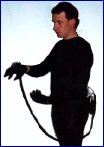
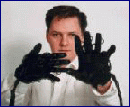
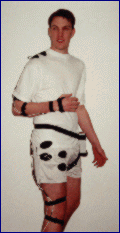

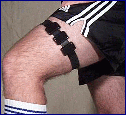


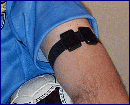
|
|
Human
Instrumentation
Solutions to Wearable Instrumentation
JKI's research in the area of physiological
monitoring and wearable instrumentation have lead to both standard products
and a modular approach to systems and devices allowing a great deal of
flexibility to custom instrumentation requirements and a straightforward
pathway to device development. Integrated Sensor Systems that you
car wear. Also, we have developed method for stick-on sensor systems,
dedicated physiological sensor data loggers, and similar devices.
Applications:
Garment Mounting
Our R&D efforts have lead to overcoming many
common challenges of wearable measurement such as Sizing, Human Factors,
Garmenting, Sterilization, Washing, Extreme Use, and Range-Of-Motion Limitations.
Depending on each application, the best mounting methods are used from
whole body garments, garment segments, strap-ons, stick-ons, or inner-pocked.
Several fabrics, glues, panels, adjustment methods, and fasteners have
been used over numerous variations.
Glove Based Mounting
The hand has a plethora of sensory information
and is in direct contact with even more, it is a natural desire in many
applications to mount sensory elements on a glove. We have provided
numerous glove-based and glove segments projects and for ergonomics, remote
monitoring, point-and-sample, and personal-probe applications. We use our
owe strap templates, or an Isotoner base.
Molding and Encased Enclosures
In harsh environments such as high humidity,
underwater, high temperatures, or dirty environments, open enclosures are
not recommended. JKI has been encapsulating, molding, or potting
devices for such applications. Devices have full operation and can
include buttons, displays, IR communications channels,
Helmet Systems
 JKI
has years of work in the areas of precision head tracking and Helmet displacement
monitoring. Our Proprietary Magnetic and Optical Sensing techniques
allow high resolution, noise immunity measurement of various head / helmet
parameters. One of our earliest patents was based on adaptive helmet
liners to prevent slipping and discoupling of tracking devices. JKI
has years of work in the areas of precision head tracking and Helmet displacement
monitoring. Our Proprietary Magnetic and Optical Sensing techniques
allow high resolution, noise immunity measurement of various head / helmet
parameters. One of our earliest patents was based on adaptive helmet
liners to prevent slipping and discoupling of tracking devices.
Shoe / Foot Mounted
 JKI's
"Running Mate" devices are high speed force and temperature measurement
for gait and running analysis. Portable measuring and data logging
devices allow analysis in actual use conditions. In this example,
we utilize a molded an instrumented sole with ankle worn signal processing
and data logging module. JKI's
"Running Mate" devices are high speed force and temperature measurement
for gait and running analysis. Portable measuring and data logging
devices allow analysis in actual use conditions. In this example,
we utilize a molded an instrumented sole with ankle worn signal processing
and data logging module.
Sensors:
Goniometers
The core of JKI's development of human based
instrumentation is our line of magnetic range of motion Goniometers.
These devices have been developed for many applications including 1D, 2D,
and 3D response to distance, angle, flexion, twisting, and other motions.
Many studies of range-of-motion (ROM) indicate that motion alone can be
used as limited exercise.
Physiological Sensors
JKI has built numerous biosensor suites
for various applications incorporating the following sensors into wearable
garments, patches, implants, strap-on systems, vehicle mounted, submerged,
extreme environment, We built our own sensors as well as integrated off-the-shelf
units to our products. Common Physiological sensors include:
-
Pulse via ElectroCardiograph
-
Pulse via IR Pulse Wave
-
Respiration
-
Body Position
-
Motion Tracking
-
Body Sounds
-
Galvanic Skin Response (GSR)
|
-
Core Temperature
-
External Temperature
-
Orientation
-
Electromyographs (EMGs)
-
ROM Quiver
-
Accumulated Induced Treppe
-
Time Exposure at Level (Dosimetry)
|
Related and External Sensors
Sensors that are typically external to the human
body but provide additional critical information can be integrated into
systems and devices. Common inputs include:
-
Orientation
-
Gravity 'G' Force
-
Impact Force
-
Load Cell / FSR Force
-
Time ( Event Synched and Duration)
|
-
Pressure / Distribution
-
Electromagnetic Noise Exposure
-
Acoustic Noise Exposure
-
Luminous Intensity
-
Vibration / Shock
|
Most off-the-shelf sensors can be incorporated
to our products.
Custom Sensors
JKI has developed several magnetic, optical,
thermal, ultrasonic, and resistive sensors for various applications where
an off-the-shelf solution can't be found. See our Custom
Sensors Section for details.
Methods:
Platform Based Architecture
Why A Platform? JKI sells systems
and devices based on a modular approach to functions and features.
Several standards were developed allowing sensors of various types, number,
and complexity to be integrated in various ways into a single system with
options like data logging, RF telemetry. This allows new applications
to be assembled from existing circuitry, hardware and software parts saving
the time and expense of redesigning for every variation.
Systems and Devices
 Systems
are collections of platform modules based on an expandable architecture
allowing numerous features and options. A trademark of a Systems
approach is a moderately large number of channels and a variety of sensor
types. An example is our ergonomically oriented human performance
monitoring suits built with 32 channels incorporating joint motion, foot
pressure, Pulse, O2, External/Core/Shoe Temp, EMG activity, Blink recording,
and GSR. Systems
are collections of platform modules based on an expandable architecture
allowing numerous features and options. A trademark of a Systems
approach is a moderately large number of channels and a variety of sensor
types. An example is our ergonomically oriented human performance
monitoring suits built with 32 channels incorporating joint motion, foot
pressure, Pulse, O2, External/Core/Shoe Temp, EMG activity, Blink recording,
and GSR.
Devices are those units that are intended for
moderate production where Platform based schematics are redesigned for
a product oriented application, using as many conventions of the platform
as necessary. Appropriate for fleet items, multiple experimental
units, or similar number requirements. An example of a device is
a unit where 50 units were needed to monitor diver physiological parameters
such as EMG exertion, external/core temp, and pressure (depth). This
device used a water-proof molded enclosure, IR communication, 24 hours
data logging, with magnetically rechargeable batteries. The platform contributions
allowed a relatively fast turn-around but maintained minimal enclosure
size, power consumption, and weight.
Custom Developments
The mainstay of our engineering service activities
is catering our platform to clients needs in small and large numbers.
Many variations in scope, application, performance, and special requirements
can be accommodated. Contact Us today
to discuss your application.
Performance Parameters
The scope and requirements of a system often
include specifications placed upon them by the application or nature of
the sensor itself. Typical performance characteristics used in the
development of system specification include: Size, Weight, Power
Consumption, Battery Life, Ruggidization, G-Shock, Operating Temperature,
Sampling Rate, Sampling Resolution, Signal Filtering Properties, Smart
Processing, Data Logging Endurance, Data Download Speed, Telemetry Medium
and Range, and Dive-Depth to name a few. We look forward to discussing
your specific requirements and needs. Our quoting process allows
for you to look at cost benefits to help you select what performance parameters
is appropriate for your situation.
//
|
|





